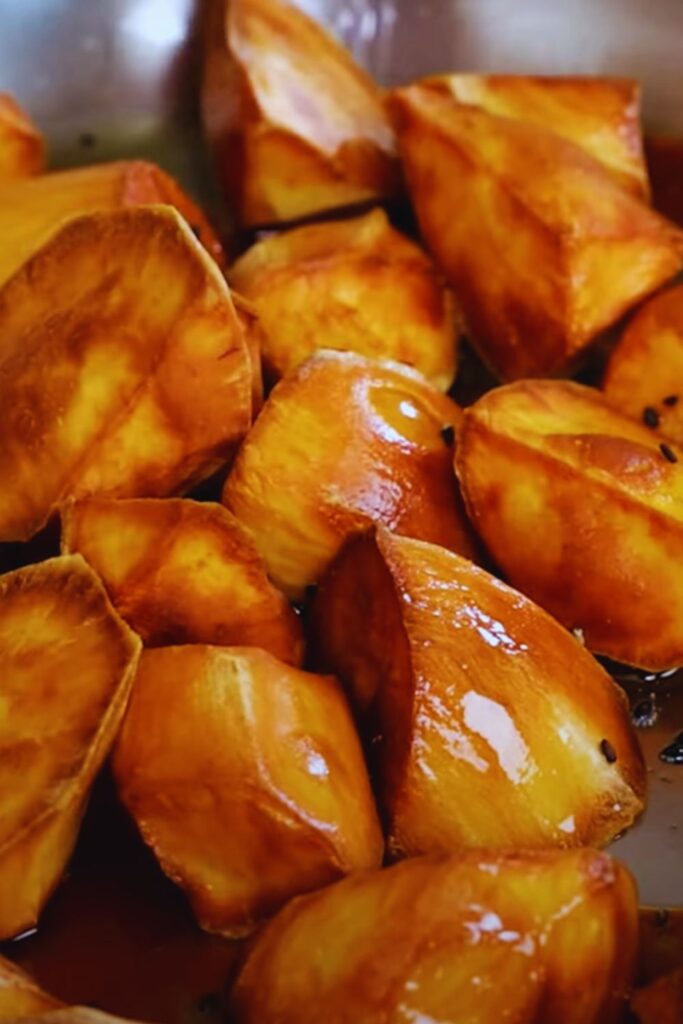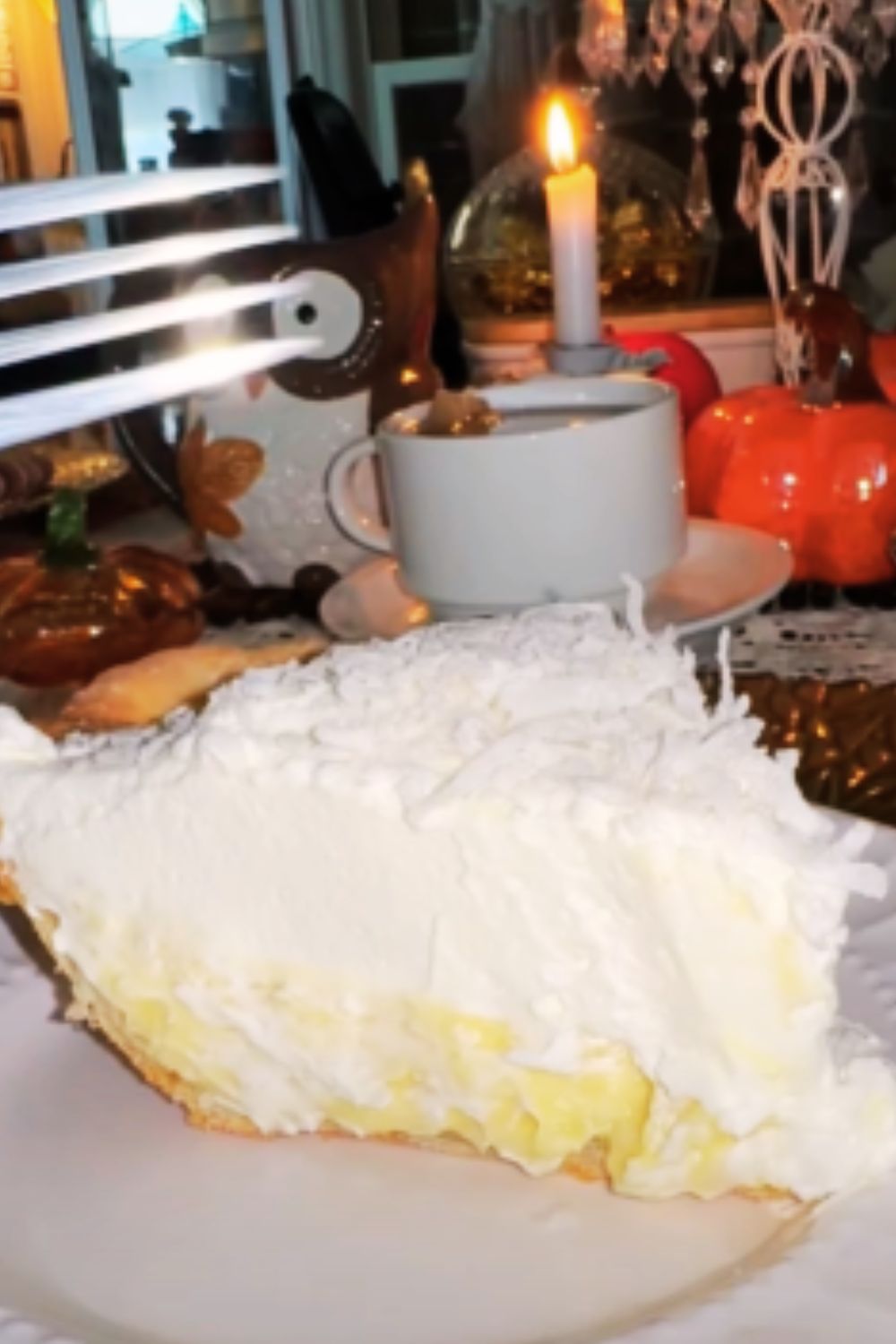There’s something magical about a dish of perfectly caramelized candied yams gracing the dinner table. The glistening orange slices bathed in a buttery, spiced syrup never fail to bring smiles all around. I’ve been perfecting my candied yams recipe for years, and today I’m thrilled to share my foolproof method with you!
Whether you’re preparing for a holiday feast or simply craving a comforting side dish on a chilly evening, these candied yams deliver warmth and satisfaction in every bite. The beauty of this recipe lies in its simplicity—a handful of ingredients transform humble root vegetables into a dish worthy of celebration.
What Are Candied Yams?
Before diving into the recipe, let’s clear up a common confusion. Despite the name “candied yams,” most recipes (including this one) actually use sweet potatoes rather than true yams. In American grocery stores and kitchens, the terms have become somewhat interchangeable, even though they’re botanically different.
Sweet Potatoes: : Orange-fleshed tubers with a sweet taste and smooth texture when cooked : Belong to the morning glory family : Commonly mislabeled as “yams” in North American stores
True Yams: : Starchy tubers with a rough, bark-like skin and white, purple, or reddish flesh : Belong to the lily family : Not commonly found in typical American grocery stores
For this recipe, we’ll use the orange-fleshed sweet potatoes often labeled as “yams” in American supermarkets. Their natural sweetness and creamy texture make them perfect for candying.
The History Behind the Dish
Candied sweet potatoes have deep roots in American culinary tradition, particularly in Southern cuisine. The dish gained popularity during the early 20th century, becoming a staple on Thanksgiving tables across the country.
The practice of sweetening sweet potatoes stems from both necessity and cultural exchange. Adding sugar and spices helped preserve the vegetable and enhance its natural sweetness. Some food historians suggest that the dish draws inspiration from West African cooking techniques brought to America during the transatlantic slave trade, where similar preparations of sweetened root vegetables were common.
Today, candied yams represent comfort food at its finest—simple ingredients transformed through tradition and care into something greater than the sum of its parts.
Ingredients You’ll Need
For approximately 8 servings, gather:
- 4 pounds sweet potatoes (about 6-7 medium potatoes)
- 1 cup packed brown sugar (light or dark, according to preference)
- ½ cup unsalted butter
- ¼ cup pure maple syrup
- 2 tablespoons orange juice (freshly squeezed if possible)
- 1 tablespoon vanilla extract
- 1 teaspoon ground cinnamon
- ½ teaspoon ground nutmeg
- ¼ teaspoon ground ginger
- ¼ teaspoon salt
- Optional: 2 tablespoons bourbon (for adults-only version)
- Optional: 1 cup miniature marshmallows for topping
Kitchen Equipment Required
While this recipe doesn’t demand specialized tools, having the right equipment makes the process smoother:
- 9×13 inch baking dish (or similar sized casserole)
- Sharp chef’s knife
- Cutting board
- Medium saucepan
- Measuring cups and spoons
- Vegetable peeler
- Aluminum foil
- Basting brush or spoon for glaze application
- Oven mitts
Preparation Steps
Selecting the Perfect Sweet Potatoes
The foundation of excellent candied yams begins at the grocery store or farmer’s market. When selecting sweet potatoes:
- Look for firm potatoes with smooth, unblemished skin
- Choose medium-sized potatoes of similar dimensions for even cooking
- Avoid any with soft spots, sprouts, or cracks
- Deeper orange flesh typically indicates higher beta-carotene content and sweeter flavor
Prepping the Sweet Potatoes
- Preheat your oven to 375°F (190°C).
- Wash sweet potatoes thoroughly under cool running water, scrubbing gently to remove any dirt.
- Pat dry with paper towels.
- Using a vegetable peeler, remove all skin from the sweet potatoes.
- Cut sweet potatoes into ½-inch thick rounds or into 1-inch chunks, depending on your preference. (I prefer rounds for more surface area to absorb the glaze!)
- Arrange the sliced sweet potatoes in the baking dish, slightly overlapping them to create a pretty pattern if using rounds.

Creating the Perfect Glaze
The glaze is what transforms ordinary sweet potatoes into candied yams:
- In a medium saucepan over medium heat, combine butter, brown sugar, maple syrup, orange juice, vanilla extract, cinnamon, nutmeg, ginger, and salt.
- If using bourbon, add it now.
- Bring the mixture to a gentle simmer, stirring occasionally.
- Continue simmering for about 5 minutes until slightly thickened and fragrant.
- Remove from heat and let cool slightly for 2-3 minutes.
- Pour the glaze evenly over the arranged sweet potatoes, ensuring all pieces receive coating.
- Use a basting brush to redistribute the glaze if necessary.
The Cooking Process
Baking to Perfection
- Cover the baking dish tightly with aluminum foil.
- Place in preheated oven and bake for 30 minutes.
- After 30 minutes, remove foil and baste the potatoes with the glaze from the bottom of the dish.
- Return to oven, uncovered, and bake for an additional 25-30 minutes.
- Baste again halfway through this uncovered baking period.
- The yams are done when they’re fork-tender and the glaze has thickened to a syrupy consistency.
Optional Marshmallow Topping
For those who enjoy the classic marshmallow-topped version:
- After the potatoes are tender (about 5 minutes before they’re completely done), remove from oven.
- Sprinkle miniature marshmallows evenly across the top.
- Return to oven and bake for 3-5 minutes, watching closely until marshmallows are puffed and golden brown.
- For extra toasting, you can briefly broil for 1-2 minutes, but don’t walk away—marshmallows can burn quickly!

Serving Suggestions
Candied yams pair beautifully with a variety of main dishes. Here are some of my favorite serving suggestions:
- Alongside roasted turkey or chicken for holiday meals
- With baked ham for a sweet-and-salty combination
- Next to a hearty meatloaf for a comforting dinner
- Complemented by green vegetables like roasted Brussels sprouts or green beans
- With cornbread and collard greens for a Southern-inspired meal
A temperature contrast often enhances the dining experience—these yams shine when served hot alongside cooler sides like cranberry sauce or a crisp green salad.
Garnishing Ideas
For an extra special presentation, consider these garnishing options:
- A light dusting of additional ground cinnamon
- Finely chopped toasted pecans or walnuts
- Thin orange zest strips
- Fresh thyme leaves
- A drizzle of additional maple syrup
- Crumbled bacon bits (for a sweet-savory contrast)
Nutritional Information
While candied yams are undeniably an indulgence, they do provide some nutritional benefits. Here’s a breakdown of approximate nutritional values per serving (based on 8 servings):
| Nutrient | Amount | % Daily Value |
|---|---|---|
| Calories | 285 | – |
| Total Fat | 8g | 10% |
| Saturated Fat | 5g | 25% |
| Cholesterol | 20mg | 7% |
| Sodium | 120mg | 5% |
| Total Carbohydrates | 52g | 19% |
| Dietary Fiber | 5g | 18% |
| Sugars | 28g | – |
| Protein | 3g | 6% |
| Vitamin A | – | 380% |
| Vitamin C | – | 30% |
| Calcium | – | 4% |
| Iron | – | 6% |
| Potassium | – | 15% |
Despite their sweetness, candied yams provide significant vitamin A from beta-carotene, as well as fiber and potassium. Moderation is key, as with all sweet treats!
Storage and Reheating
One of the best things about candied yams is how well they store and reheat:
Refrigerator Storage
- Allow leftover candied yams to cool completely.
- Transfer to an airtight container.
- Refrigerate for up to 4 days.
Freezer Storage
- Cool completely after cooking.
- Transfer to freezer-safe containers or heavy-duty freezer bags.
- Label with the date and freeze for up to 3 months.
- Thaw overnight in the refrigerator before reheating.
Reheating Methods
For best results when reheating:
Oven Method (Preferred)
- Preheat oven to 350°F (175°C).
- Place refrigerated yams in an oven-safe dish.
- Add 1-2 tablespoons of water or orange juice to prevent drying.
- Cover with foil and heat for 15-20 minutes until warm throughout.
- Remove foil for the last 5 minutes if you want to recrisp the top.
Microwave Method (Quick Option)
- Place portion in a microwave-safe dish.
- Cover with a damp paper towel to maintain moisture.
- Heat on medium power for 1-2 minutes.
- Stir and continue heating in 30-second intervals until warmed through.
The flavor of candied yams often deepens overnight, making them potentially even more delicious the next day!
Variations to Try
While this classic recipe stands beautifully on its own, consider these variations to switch things up:
Maple-Pecan Candied Yams
- Add 1 cup chopped pecans to the glaze
- Increase maple syrup to ⅓ cup
- Reduce brown sugar to ¾ cup
- Sprinkle with additional toasted pecan pieces before serving
Citrus-Spice Candied Yams
- Add 1 tablespoon orange zest to the glaze
- Include ¼ teaspoon ground cloves
- Use half orange juice and half lemon juice for a brighter flavor profile
- Garnish with additional fresh citrus zest
Coconut-Rum Tropical Twist
- Substitute coconut sugar for brown sugar
- Replace butter with coconut oil
- Add 2 tablespoons dark rum to the glaze
- Top with toasted coconut flakes instead of marshmallows
Savory-Sweet Rosemary Candied Yams
- Reduce brown sugar to ⅔ cup
- Add 1 tablespoon fresh rosemary leaves to the glaze
- Include 1 tablespoon balsamic vinegar
- Finish with flaky sea salt and additional fresh rosemary

Troubleshooting Common Issues
Even experienced cooks occasionally encounter challenges. Here are solutions to common candied yam problems:
| Problem | Possible Cause | Solution |
|---|---|---|
| Yams are too firm | Insufficient cooking time | Cover dish again with foil and bake for additional 10-15 minute increments until tender |
| Glaze is too runny | Not enough reduction time | After baking, carefully pour excess liquid into saucepan and simmer until reduced, then pour back over yams |
| Glaze burned | Oven too hot or positioned too close to heating element | Lower oven rack, reduce temperature by 25°F, and watch closely during final cooking stage |
| Marshmallows burned | Broiler too hot or left unattended | Keep oven door cracked while broiling and watch continuously |
| Unevenly cooked potatoes | Potato pieces cut to different sizes | Try to cut all pieces to uniform thickness; separate larger and smaller pieces into different sections of the dish |
| Too sweet | Individual preference varies | Balance with 1-2 teaspoons of lemon juice or a pinch of salt added to the glaze |
Make-Ahead Tips for Busy Cooks
Holiday cooking can be stressful—these make-ahead strategies help manage the chaos:
One Day Ahead
- Prepare and slice the sweet potatoes.
- Store in cold water in the refrigerator to prevent browning.
- Drain and pat dry before assembling.
- Prepare the glaze and refrigerate separately.
- Assemble and bake the next day.
Partially Baked (My Preferred Method)
- Follow the recipe through the covered baking stage.
- Cool completely, then refrigerate.
- On serving day, bring to room temperature for 30 minutes.
- Complete the uncovered baking portion until hot and bubbling.
- Add marshmallows, if using, during the final minutes.
Fully Prepared
- Bake the dish completely (without marshmallows).
- Cool, cover, and refrigerate.
- Reheat covered at 350°F for 20-25 minutes until hot.
- Add marshmallows for the final 5 minutes if desired.
Frequently Asked Questions
Q: Can I use canned sweet potatoes/yams for this recipe?
A: Yes, you can substitute canned sweet potatoes in a pinch. Drain them well and reduce the initial covered baking time to 15 minutes since they’re already fully cooked. Keep in mind that the texture may be softer and the flavor slightly different than fresh sweet potatoes.
Q: Are sweet potatoes and yams the same thing?
A: Despite common labeling in American grocery stores, sweet potatoes and true yams are different vegetables. What we typically call “yams” in the US are actually varieties of sweet potatoes. True yams are starchier, less sweet, and rarely found in standard American grocery stores.
Q: Can I make this recipe vegan?
A: Absolutely! Substitute the butter with coconut oil or vegan butter. Check that your marshmallows are gelatin-free if using them, or skip them entirely. The dish is still delicious without them!
Q: How can I reduce the sugar content while maintaining flavor?
A: Try reducing the brown sugar by up to half and rely more on the natural sweetness of the sweet potatoes. You can also use a sugar substitute designed for baking, though this may affect the texture of the glaze. Adding more spices like cinnamon and nutmeg can help maintain flavor complexity with less sugar.
Q: Why are my candied yams watery?
A: This typically happens when the glaze hasn’t reduced enough during baking. Make sure you’re baking uncovered long enough, and if needed, carefully pour the excess liquid into a saucepan and reduce it on the stovetop before pouring back over the potatoes.
Q: Can I prepare this dish in a slow cooker?
A: Yes! Layer the sweet potatoes in a greased slow cooker, pour the prepared glaze over them, and cook on low for 4-5 hours or high for 2-3 hours until tender. The glaze won’t reduce as much in a slow cooker, so you might want to start with less liquid or reduce the glaze on the stovetop first.
Q: What’s the best way to cut sweet potatoes safely?
A: Start with a stable cutting surface and a sharp knife. Cut a thin slice from one side of the sweet potato to create a flat base, then place that side down for stability. Slice carefully using a rocking motion, keeping fingers curled under and away from the blade.
Q: Can I add other root vegetables to this dish?
A: Certainly! Carrots, parsnips, or even apples can be added for variety. Just be aware that different vegetables have different cooking times, so you may need to adjust accordingly or pre-cook harder vegetables before combining them.
Why This Recipe Works
After years of tweaking and testing, I’ve found that the success of this recipe comes down to a few key factors:
- The two-stage baking process: First covered to steam and soften the potatoes, then uncovered to reduce and caramelize the glaze
- Balanced spices: Just enough to complement the sweet potatoes without overwhelming them
- Multiple flavoring agents: Brown sugar for depth, maple syrup for complexity, and a touch of orange juice for brightness
- Proper potato preparation: Uniform slices ensure even cooking
- Frequent basting: This ensures every piece gets coated in the developing glaze
The result is tender sweet potatoes with a perfectly reduced syrup that clings to each piece—never watery, never dry.
Final Thoughts
Candied yams represent comfort food at its finest—simple ingredients transformed through love and care into something truly special. Whether gracing your holiday table or bringing warmth to a weekend family dinner, this dish connects us to culinary traditions while delighting our taste buds.
I’ve shared this recipe at countless gatherings, and the empty dish at the end of the meal is always my favorite review. There’s something deeply satisfying about watching people discover (or rediscover) the simple pleasure of perfectly prepared candied yams.
Remember that recipes are guidelines, not rules. Feel free to adjust the sweetness, spices, or cooking methods to suit your preferences. The best version of this dish is the one that makes you and your loved ones smile.
Happy cooking!




